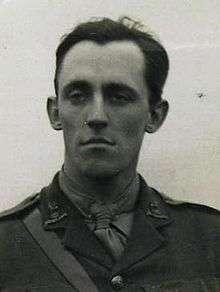Edye Rolleston Manning
Air Commodore Edye Rolleston Manning, CBE, DSO, MC (14 February 1889 – 26 April 1957) was an Australian-born senior officer in the Royal Air Force.[1][2][3][4][5] In the early days of the Second World War he was tasked with establishing a string of airfields in the Far East from Lashio to Mingladon.[6][7][8]
Edye Rolleston Manning | |
|---|---|
 | |
| Born | 14 February 1889 Sydney, Australia |
| Died | 26 April 1957 (aged 68) |
| Allegiance | |
| Service/ | |
| Years of service | 1914–1935 1939–1945 |
| Rank | Air Commodore |
| Commands held | No. 221 Group RAF (1941) RAF Manston (1933–36) RAF Hornchurch (1930–33) No. 7 Squadron (1928–29) RAF Northolt (1927–28) No. 6 Squadron (1922–24) No. 6 Stores Depot (1919–20) |
| Battles/wars | First World War Second World War |
| Awards | Commander of the Order of the British Empire Distinguished Service Order Military Cross |
Early life
Edye Rolleston Manning was born in Australia on 14 February 1889, the son of William Alexander Manning, a solicitor practising in Sydney, Australia.[3][9] He was educated at Bedford Modern School in England before going on to study medicine at the University of Edinburgh.[3]
Military career
When the First World War broke out, Manning ceased his studies at Edinburgh and joined the cavalry, serving in France and Belgium with the 15th Hussars.[3][10] Frustrated by the stalemate of trench warfare he transferred to the Royal Flying Corps where he attained RAeC Certificate No. 2253 on 9 October 1916.[11] He was wounded at the Battle of the Somme in July 1916 while serving with No. 3 Squadron.[11]
As Commanding Officer of No. 6 Squadron, Manning was responsible for the evacuation of the British High Commissioner from Suliemanieh in Kurdistan, after which he was made a Companion of the Distinguished Service Order.[11] In 1928 he chose to go on half-pay in order to attempt a flight from England to Australia in a Westland Widgeon he owned privately.[12][13] He got as far as Tunis before crashing at Lebda; Manning was uninjured but his plane was a write-off and he was forced to abandon the attempt.[11]
After his aborted flight, Manning became Officer Commanding of RAF Hornchurch (1930)[14] and RAF Manston (1933)[15] before retiring in 1935 to become a stockbroker in Sydney.[10][11] At the advent of the Second World War he was persuaded to return to the Royal Air Force, becoming Officer Commanding No. 221 Group (RAF) as a group captain in March 1941, establishing a "string of airfields stretching from Lashio to Mingladon".[11][16] In January 1942 he was appointed Air Commodore of the Group.[11]
Manning died on 26 April 1957.[10] There is a photographic portrait of Manning at the National Portrait Gallery, London.[17]
References
- Obituary in The Times, Air CDRE. E.J. Manning, 29 April 1957, p.12
- "Who's who in Australia". google.com. Retrieved 14 November 2015.
- "The Aeroplane". google.com. Retrieved 14 November 2015.
- "Debrett's Baronetage, Knightage, and Companionage ..." google.com. Retrieved 14 November 2015.
- https://www.thegazette.co.uk/London/issue/37124/supplement/3073/data.pdf
- "Disaster in the Far East 1940– 1942". google.com. Retrieved 14 November 2015.
- "The British Empire and the Second World War". google.com. Retrieved 14 November 2015.
- "Fortnight of Infamy". google.com. Retrieved 14 November 2015.
- "Debrett's Peerage, Baronetage, Knightage, and Companionage". google.com. Retrieved 14 November 2015.
- "E R Manning_P". rafweb.org. Retrieved 14 November 2015.
- "The Quiet Australian". google.com. Retrieved 14 November 2015.
- "Flight International". google.com. Retrieved 14 November 2015.
- "Aviation Week and Space Technology". google.com. Retrieved 14 November 2015.
- "1930 – 0503 – Flight Archive". flightglobal.com. Retrieved 14 November 2015.
- "1935 – 2- 0259 – Flight Archive". flightglobal.com. Retrieved 14 November 2015.
- "Far East Air Operations 1942–1945". google.com. Retrieved 14 November 2015.
- "Edye Rolleston Manning". npg.org.uk. Retrieved 14 November 2015.